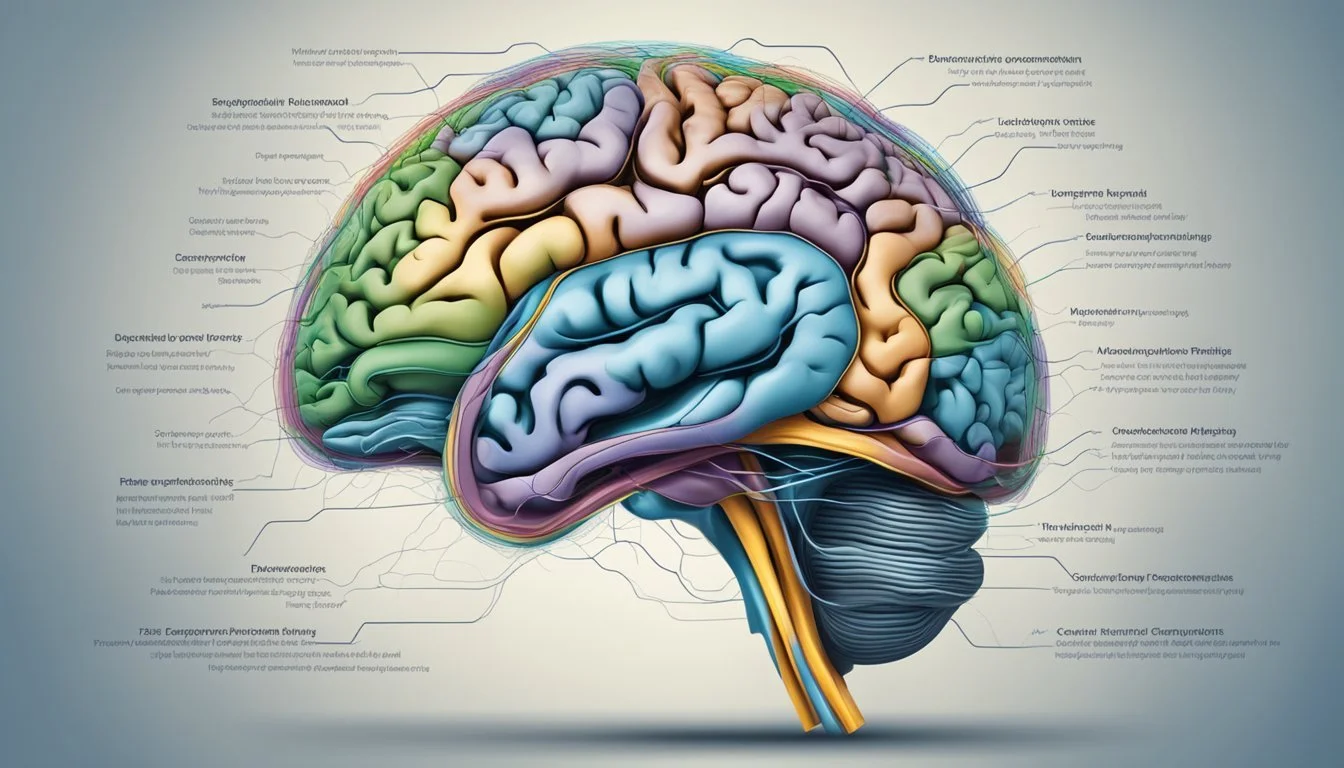Exploring the Psychopath's Profile: How It Aligns with the Big 5 Personality Traits
Psychopathy, a personality trait characterized by low empathy and high impulsivity, has intrigued researchers and psychologists for decades. When examined through the lens of the widely accepted Big Five personality model, psychopathy reveals interesting correlations with certain traits.
Studies have found that psychopathy tends to correlate negatively with agreeableness and conscientiousness, two of the Big Five personality factors. This means individuals scoring high on psychopathy measures often display lower levels of these traits. They may struggle with empathy, cooperation, and following social norms - hallmarks of low agreeableness. Similarly, their impulsive nature and thrill-seeking tendencies align with lower conscientiousness scores.
The relationship between psychopathy and the other Big Five traits - extraversion, neuroticism, and openness - is less clear-cut and may vary depending on the specific aspects of psychopathy being measured. Understanding these connections can provide valuable insights into the complex nature of psychopathic traits and their impact on behavior and interpersonal relationships.
Understanding Psychopathy
Psychopathy is a complex personality disorder characterized by specific traits and behaviors. It falls under the broader category of antisocial personality disorders.
Key features of psychopathy include:
Superficial charm
Impulsivity
Disregard for social norms
Psychopaths often display a grandiose sense of self-worth and engage in pathological lying. They may appear charming and charismatic on the surface, but lack genuine emotional connections.
Research suggests psychopathy exists on a spectrum rather than as a binary condition. Some individuals may exhibit more traits or behaviors associated with psychopathy than others.
The relationship between psychopathy and the Big Five personality traits has been studied extensively. Psychopathic individuals typically score:
Low on agreeableness
Low on conscientiousness
High on neuroticism
Variable on extraversion and openness
It's important to note that not all individuals with psychopathic traits engage in criminal behavior. Some may function in society, albeit with difficulties in personal relationships and ethical decision-making.
Psychological assessments and clinical interviews are used to diagnose psychopathy. Treatment options are limited but may include therapy focused on behavior modification and impulse control.
The Big Five Personality Model
The Big Five personality model is a widely accepted framework for understanding human personality. It identifies five broad dimensions that capture key aspects of individual differences in behavior, thoughts, and emotions.
Openness
Openness reflects a person's curiosity, creativity, and willingness to try new experiences. Individuals high in openness tend to be imaginative, artistic, and intellectually curious. They often seek out novel ideas and engage in abstract thinking.
Those low in openness prefer familiarity and routine. They may be more practical and traditional in their approach to life. Openness can influence a person's interests, hobbies, and career choices.
Conscientiousness
Conscientiousness relates to organization, self-discipline, and goal-directed behavior. Highly conscientious individuals are typically responsible, reliable, and hardworking. They excel at planning and following through on tasks.
Low conscientiousness is associated with being disorganized, impulsive, and less focused on long-term goals. This trait strongly predicts academic and occupational success.
Extraversion
Extraversion measures a person's tendency to seek social interaction and stimulation. Extraverts are outgoing, talkative, and energized by social situations. They often take on leadership roles and enjoy being the center of attention.
Introverts, on the other hand, prefer solitary activities and feel drained by excessive social interaction. Extraversion influences a person's social network size, job performance in certain roles, and overall well-being.
Agreeableness
Agreeableness reflects an individual's tendency to be cooperative, compassionate, and trusting. Highly agreeable people are empathetic, kind, and avoid conflict. They prioritize maintaining harmonious relationships with others.
Low agreeableness is characterized by competitiveness, skepticism, and a focus on self-interest. This trait can impact interpersonal relationships, teamwork abilities, and leadership styles.
Neuroticism
Neuroticism represents emotional stability and the tendency to experience negative emotions. Individuals high in neuroticism are prone to anxiety, mood swings, and stress. They may be more sensitive to criticism and worry frequently.
Those low in neuroticism tend to be emotionally stable, calm under pressure, and resilient. This trait influences how people cope with challenges, their overall life satisfaction, and their risk for certain mental health issues.
Psychopathy and the Big Five
Psychopathy is a complex personality disorder with distinct relationships to the Big Five personality traits. These connections provide insights into the core features of psychopathic individuals and their behavioral tendencies.
Low Agreeableness and Psychopathy
Psychopaths typically score low on Agreeableness, a key Big Five trait. This low score manifests in callousness, lack of empathy, and interpersonal manipulation - hallmarks of Factor 1 psychopathy.
Individuals high in psychopathic traits often struggle with forming genuine connections. They may exploit others for personal gain without remorse.
Research using the Hare Psychopathy Checklist-Revised (PCL-R) shows strong negative correlations between psychopathy scores and Agreeableness. This relationship is particularly evident in the interpersonal and affective facets of psychopathy.
Low Conscientiousness in Psychopaths
Psychopathic individuals frequently exhibit low Conscientiousness. This trait is associated with impulsivity, poor planning, and a lack of long-term goals - characteristics of Factor 2 psychopathy.
Low Conscientiousness in psychopaths contributes to:
Erratic work history
Failure to fulfill obligations
Difficulty following rules and norms
These behaviors align with the lifestyle facet of the PCL-R. Psychopaths often act without considering consequences, leading to antisocial and criminal behaviors.
Studies show negative correlations between psychopathy scores and Conscientiousness measures. This relationship is particularly strong for the impulsive and antisocial aspects of psychopathy.
Psychopathy and High Neuroticism
The relationship between psychopathy and Neuroticism is complex. Some psychopaths exhibit low anxiety and emotional stability, while others show high Neuroticism.
Primary psychopaths often display low Neuroticism. They remain calm under pressure and show limited anxiety or emotional distress.
Secondary psychopaths, however, may score higher on Neuroticism. They experience:
Emotional instability
Anxiety
Mood swings
This difference highlights the heterogeneity within psychopathy. It suggests distinct subtypes with varying emotional profiles and potential etiologies.
Extraversion and Psychopathic Traits
Psychopathy often correlates positively with Extraversion. This connection relates to the boldness and charisma associated with many psychopathic individuals.
Extraverted psychopaths may be:
Socially dominant
Persuasive
Excitement-seeking
These traits can make psychopaths appear charming and confident. They may use these qualities to manipulate others or gain positions of power.
The relationship between Extraversion and psychopathy is most evident in the interpersonal facet of the disorder. It contributes to the "mask of sanity" that some psychopaths present to the world.
The Role of Openness in Psychopathy
Openness to Experience has a less clear relationship with psychopathy compared to other Big Five traits. Some studies find weak positive correlations, while others show no significant association.
Psychopaths may display certain aspects of Openness, such as:
Willingness to try new experiences
Unconventional thinking
Creativity in criminal endeavors
However, they often lack the depth of emotional and intellectual curiosity associated with high Openness. Their openness to experience may be more superficial and self-serving.
The relationship between Openness and psychopathy requires further research. It may vary depending on the specific psychopathy measure used and the population studied.
Associations with Other Personality Models
Psychopathy intersects with several established personality frameworks. Its connections to the Dark Triad and HEXACO model provide insight into how this trait manifests across different theoretical approaches.
Psychopathy and the Dark Triad
Psychopathy forms one component of the Dark Triad, alongside narcissism and Machiavellianism. These three traits share commonalities in their callous, manipulative nature. Psychopathy correlates positively with both narcissism and Machiavellianism, though each retains distinct features.
Narcissism involves grandiosity and attention-seeking, while Machiavellianism centers on strategic manipulation. Psychopathy uniquely emphasizes impulsivity and lack of empathy. Studies show psychopathy has the strongest link to antisocial behavior among Dark Triad traits.
Research indicates psychopathy may be the "darkest" of the three, exhibiting the lowest levels of agreeableness and conscientiousness. This aligns with psychopathy's association with reckless, amoral conduct.
Comparison to the HEXACO Model
The HEXACO model expands on the Big Five by adding a sixth factor: Honesty-Humility. This dimension captures traits like sincerity and fairness, often lacking in psychopathic individuals.
Psychopathy shows strong negative correlations with HEXACO's Honesty-Humility and Emotionality factors. Low Honesty-Humility reflects tendencies toward exploitation and deceit. Reduced Emotionality aligns with psychopathy's characteristic lack of fear and empathy.
HEXACO's Agreeableness factor differs slightly from the Big Five version, focusing more on patience and forgiveness. Psychopathy correlates negatively with both conceptualizations of Agreeableness, highlighting interpersonal difficulties.
Conscientiousness in HEXACO mirrors the Big Five dimension. Psychopathy's negative relationship with this trait underscores issues with impulse control and responsibility.
Prevalence and Predictors of Psychopathy
Psychopathy prevalence rates vary depending on the assessment method used. Studies using instruments other than the PCL-R found higher rates, with a combined prevalence of 5.4% in the general adult population.
Research using the PCL-R and its variants reported lower rates, averaging 1.2%. These figures suggest psychopathy is relatively rare but still affects a significant number of individuals.
Several factors predict psychopathic traits. Genetic influences play a role, with heritability estimates ranging from 40-60%. Environmental factors like childhood maltreatment and dysfunctional family dynamics also contribute.
Personality traits correlate with psychopathy. Low agreeableness and conscientiousness, coupled with high neuroticism, are associated with increased psychopathic tendencies.
Juvenile psychopathy is a growing area of study. The Pittsburgh Youth Study found that 16-year-old boys with psychopathic traits were more likely to engage in serious and violent offending.
Research on high school students revealed links between psychopathic traits and aggression. A study of Italian adolescents found associations between psychopathy dimensions and Big Five personality traits.
Early identification of psychopathic traits in youth may help prevent negative outcomes. However, caution is needed when applying adult psychopathy concepts to juveniles due to ongoing personality development.
Psychopathy in Different Populations
Psychopathy manifests differently across various populations. While often associated with criminal behavior, it also occurs in non-criminal groups.
In the general adult population, estimates of psychopathy prevalence vary. Using self-report measures like the Levenson Self-Report Psychopathy Scale (LSRP), prevalence may reach around 5.4%.
Psychopathy in mothers has garnered research attention. Some studies suggest psychopathic traits can impact parenting behaviors and child outcomes.
The Psychopathic Personality Inventory (PPI) helps assess psychopathic traits in non-forensic populations. It measures factors like fearless dominance and self-centered impulsivity.
Psychopathy rates tend to be higher in forensic settings compared to the general population. However, many individuals with psychopathic traits function in society without engaging in criminal acts.
Health professionals have observed psychopathic traits in corporate and political leaders. These individuals may exhibit charm, ruthlessness, and lack of empathy.
Cultural differences can influence the expression and perception of psychopathic traits. What's considered psychopathic may vary across societies.
Gender differences in psychopathy prevalence and expression have been noted. Some research suggests higher rates in males, though this remains debated.
Adolescents can display psychopathic traits, prompting early intervention efforts. The Youth Psychopathic Traits Inventory (YPI) aids in assessing these traits in younger populations.
Neurobiological and Developmental Factors
Psychopathy has complex neurobiological underpinnings that interact with developmental processes. Research suggests that brain structure and function play a significant role in the emergence of psychopathic traits.
Key brain areas implicated include the amygdala, prefrontal cortex, and limbic system. These regions are involved in emotion processing, decision-making, and impulse control.
Genetic factors also contribute to psychopathy risk. Studies have identified specific genes linked to psychopathic tendencies, though their influence is not deterministic.
Environmental factors, particularly early life experiences, shape personality development. Childhood trauma, neglect, and inconsistent parenting can increase the likelihood of psychopathic traits emerging.
The California Child Q-Set, a personality assessment tool, has been used to study how psychopathic traits manifest in children. It helps identify early signs of callous-unemotional traits and antisocial behaviors.
Neurobiological frameworks propose that psychopathy results from atypical neural development. This leads to deficits in fear processing, empathy, and moral reasoning.
Longitudinal studies show that psychopathic traits often emerge in childhood and persist into adulthood. Early intervention targeting these traits may help prevent the full development of psychopathy.
Personality development in psychopathy is characterized by low agreeableness, low conscientiousness, and high neuroticism within the Big Five model. These traits interact with neurobiological factors to shape behavior.
Assessment and Measurement Tools
The Big Five personality model provides a framework for assessing psychopathic traits. Several instruments have been developed to measure these characteristics within this context.
The NEO-PI-R (Revised NEO Personality Inventory) is a widely used tool that evaluates the five personality factors. It includes 240 items and provides detailed insights into an individual's personality profile.
The Psychopathic Personality Inventory (PPI) is another valuable instrument. It specifically targets psychopathic traits and consists of 187 items across eight subscales.
For assessing children and adolescents, the Child Behavior Checklist offers a comprehensive evaluation of behavioral and emotional problems. It includes items related to psychopathic tendencies.
Researchers often employ regression analyses to examine the relationships between psychopathic traits and Big Five personality factors. These statistical methods help identify significant correlations and predictive patterns.
It's important to note that no single test can definitively diagnose psychopathy. Mental health professionals typically use a combination of assessment tools, clinical interviews, and behavioral observations to make accurate evaluations.
Ongoing research continues to refine these measurement tools, improving their reliability and validity in assessing psychopathic traits within the Big Five framework.
Prevention and Intervention Strategies
Early identification of psychopathic traits in children and adolescents is crucial for effective prevention. Screening tools can help detect conduct problems and aggressive behaviors associated with psychopathic tendencies.
Interventions targeting emotion recognition and empathy development show promise. These programs aim to improve social skills and reduce callous-unemotional traits in youth.
Parent training programs focus on enhancing positive parenting practices and consistent discipline. These approaches help address conduct problems and aggression in children at risk for psychopathic personality development.
Cognitive-behavioral therapy (CBT) has demonstrated some effectiveness in treating adults with psychopathic traits. CBT techniques aim to modify dysfunctional thought patterns and improve impulse control.
Multisystemic therapy, an intensive family-based intervention, has shown positive results in reducing antisocial behaviors among high-risk youth. This approach addresses multiple risk factors across various social contexts.
Pharmacological interventions, while not a primary treatment, may help manage specific symptoms associated with psychopathy. Mood stabilizers and antipsychotics can be used to address aggression and impulsivity.
Key prevention strategies:
Early identification and intervention
Emotion recognition training
Parent education programs
School-based social skills interventions
Reliability of prevention and intervention outcomes varies, with some studies showing mixed results. Long-term follow-up studies are needed to assess the durability of treatment effects.
Emotional Processing and Social Cognition
Psychopaths exhibit distinct patterns in emotional processing and social cognition compared to the general population. Research has shown they struggle to recognize and respond appropriately to certain emotional expressions, particularly those conveying sadness and fear.
This impairment in processing sad and fearful expressions may contribute to their reduced empathy and callous behavior. Brain imaging studies have revealed reduced activity in areas associated with emotion processing when psychopaths view distressed facial expressions.
Psychopaths often display a facade of emotional stability and charm. However, this masks an underlying emotional detachment and shallow affect. They may mimic appropriate emotional responses without genuinely feeling them.
Social cognition deficits are also evident in psychopathy. Individuals high in psychopathic traits often misinterpret social cues and struggle with perspective-taking. This can lead to difficulties in forming genuine relationships and understanding others' mental states.
Some key areas affected in psychopaths include:
Facial emotion recognition
Empathic responding
Theory of mind
Emotional resonance
Affective perspective-taking
These impairments in emotional processing and social cognition likely contribute to the interpersonal and behavioral manifestations of psychopathy. Understanding these deficits is crucial for developing targeted interventions and refining diagnostic criteria.
Personality and Pathological Traits
Psychopathy intersects with both normal personality traits and pathological characteristics. The Big Five model provides a framework for understanding typical personality dimensions, including extraversion, agreeableness, conscientiousness, neuroticism, and openness.
Individuals with psychopathic tendencies often display a distinct pattern across these traits. They may score low on agreeableness and conscientiousness, while showing elevated levels of extraversion and openness in some cases.
Pathological personality traits offer additional insight into psychopathy. The DSM-5 dimensional model identifies key traits associated with personality disorders. For psychopathy, traits like antagonism, disinhibition, and low levels of anxiousness are particularly relevant.
Research using the Personality Inventory for DSM-5 (PID-5) has helped characterize psychopathy in terms of these pathological traits. Studies indicate that facets of psychopathy align with specific PID-5 dimensions, providing a more nuanced understanding of the condition.
Stable personality functioning is another important consideration. While some traits may fluctuate, core psychopathic features tend to persist over time. This stability contributes to the enduring nature of psychopathic patterns in cognition, emotion, and behavior.
By examining both normal range personality traits and pathological characteristics, researchers gain a more comprehensive view of psychopathy. This integrated approach enhances our understanding of the condition's complex manifestations across different domains of personality functioning.









